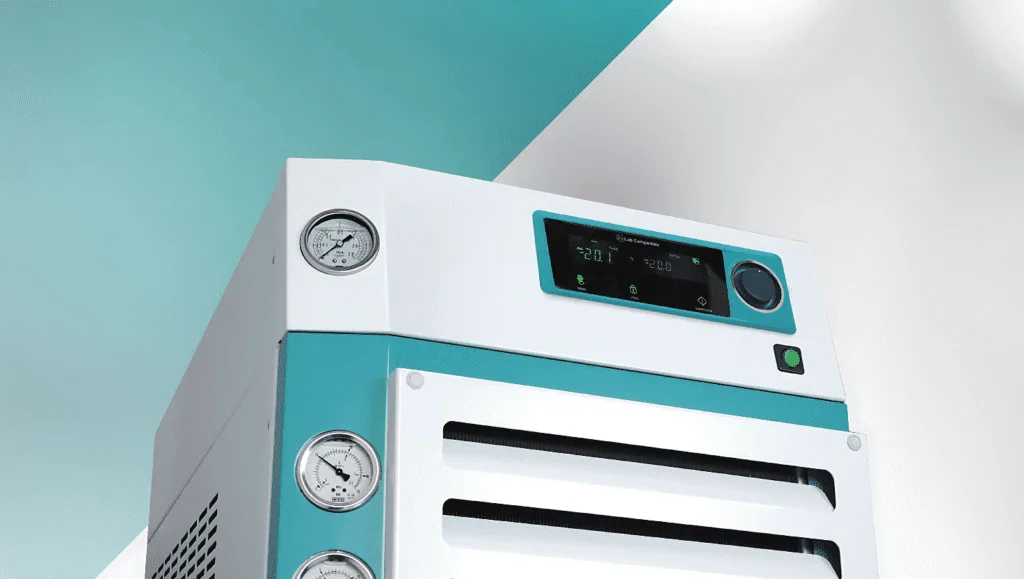Recirculating chillers are vital in laboratories and industrial settings where precise temperature control is crucial for equipment such as rotary evaporators, analytical instruments, and reactor vessels. Selecting the right recirculating chiller is key to maintaining efficiency, reliability, and cost-effectiveness in laboratory operations. This article will guide you through the essential specifications, uses, and considerations when choosing the perfect recirculating chiller for your laboratory.
What is a Recirculating Chiller?
A recirculating chiller is a closed-loop cooling system designed to circulate a coolant—typically water or a water-glycol mixture—through laboratory or industrial equipment to remove heat and maintain a stable temperature. Unlike tap water cooling, which can waste water and lacks temperature control, recirculating chillers provide a more sustainable, controlled cooling solution, essential for labs in South Africa looking to optimize operations.
Applications of Recirculating Chillers
Recirculating chillers serve multiple applications in laboratories and industrial environments, including:
- Rotary Evaporators – Essential for solvent evaporation, where cooling improves recovery rates and prevents overheating.
- Analytical Instruments – Supports mass spectrometers, electron microscopes, and X-ray diffraction equipment by maintaining precise operating temperatures.
- Reactor Vessels & Bioreactors – Ensures consistent temperature control for chemical reactions, fermentation, and biological processes.
- Laser Systems – Prevents overheating of laser components, improving performance and extending lifespan.
- Medical & Pharmaceutical Cooling – Applied in drug formulation, diagnostics, and medical imaging systems.
- Industrial & Manufacturing Processes – Regulates temperature in applications such as injection molding, metalworking, and semiconductor production.
Key Factors to Consider When Choosing a Recirculating Chiller
1. Cooling Capacity (W or kW)
The cooling capacity of a chiller defines how much heat it can remove from equipment per unit of time. Properly matching the chiller’s cooling capacity to your equipment’s heat load is essential for optimal temperature maintenance. A chiller with insufficient capacity will struggle to maintain the required temperature, while an oversized chiller could lead to energy inefficiency.
How to Choose:
- Calculate your equipment’s total heat load (in watts or kilowatts).
- Ensure the chiller’s capacity exceeds the calculated load slightly to account for heat losses.
2. Temperature Range and Stability
Different applications may require different temperature ranges. Some recirculating chillers offer only cooling, while others have both heating and cooling capabilities.
How to Choose:
- For general cooling applications like rotary evaporators, a range of -10°C to 30°C is sufficient.
- For specialized needs, such as reactor vessels, look for models with a range from -20°C to 100°C.
- Ensure temperature stability of ±0.1°C to ±0.5°C for high-precision applications.
3. Pump Flow Rate and Pressure
The pump flow rate (liters per minute, L/min) and pressure (bar or psi) are important to ensure effective circulation of coolant.
How to Choose:
- Small-scale applications require low-flow chillers (2-5 L/min).
- For large-scale or multi-equipment systems, opt for high-flow chillers (10+ L/min).
- Verify the pressure rating to match your equipment’s specifications.
4. Type of Refrigerant
Environmental impact is a growing concern in laboratory cooling. Modern recirculating chillers use eco-friendly refrigerants with low global warming potential (GWP).
How to Choose:
- Look for chillers using R-134a, R-410A, or other environmentally-friendly refrigerants that comply with regulations
5. Air-Cooled vs. Water-Cooled Chillers
- Air-Cooled Chillers: Use fans to release heat into the surrounding air and are ideal for labs with adequate ventilation.
- Water-Cooled Chillers: Utilize a secondary water source for cooling, making them better suited for high-heat applications but requiring additional plumbing
How to Choose
- For labs with limited ventilation, a water-cooled chiller may provide more efficient cooling.
- If plumbing is impractical, an air-cooled chiller is more convenient.
6. Noise Levels
High-performance chillers can generate significant noise, which might be disruptive in quieter lab environments.
How to Choose:
- For noise-sensitive settings, opt for chillers with low-noise compressors and vibration-dampening features.
- Always check the decibel (dB) rating in the manufacturer’s specifications.
7. Footprint and Space Requirements
Laboratory space is often at a premium, making it essential to choose a chiller that fits within your space constraints.
How to Choose:
- If space is limited, consider compact benchtop chillers.
- For higher capacity, floor-standing models are available, though they require more space.
8. Energy Efficiency
Energy-efficient chillers reduce both operational costs and environmental impact, making them an important consideration for sustainable lab operations.
How to Choose:
- Compare the power consumption of various models.
- Opt for chillers with variable-speed compressors or eco-modes to reduce energy usage.
Accessories and Additional Features to Consider
- External Temperature Probes: For direct temperature monitoring of samples.
- USB/Data Logging: Enables remote monitoring and recording of temperature data.
- Coolant Reservoir Size: Larger reservoirs ensure a consistent supply of coolant but take up more space.
- Water Quality Monitoring: Prevents issues such as scale buildup, improving the longevity of your chiller.
- Safety Features: Over-temperature alarms, low-fluid level alerts, and circuit protection for enhanced reliability.
Comparison of Chillers Available from Apex Scientific
Explore our Recirculating Chillers Collection for a wide range of models suited for various laboratory needs.
| Model | Cooling Capacity | Temperature Range | Pump Flow Rate | Refrigerant | Special Features |
| Jeiotech RW3-0510G | 500W | -10°C to 30°C | 8 L/min | R-134a | Compact, energy-efficient |
| Jeiotech RW3-1025G | 1000W | -20°C to 35°C | 12 L/min | R-410A | Large reservoir, precise control |
Being International Cooling Chiller | 750W | -15°C to 25°C | 10 L/min | Eco-friendly | Compact, quiet operation |
For more details on available models, check out our Recirculating Chillers page.
Conclusion
Selecting the right recirculating chiller for your laboratory in South Africa requires careful consideration of cooling capacity, temperature range, pump flow rate, energy efficiency, and other key factors. By evaluating your specific needs, you can ensure the best performance and longevity for your lab equipment. At Apex Scientific, we are committed to providing you with top-quality laboratory equipment tailored to your needs.
For expert advice and a comprehensive selection of recirculating chillers, contact Apex Scientific today!




